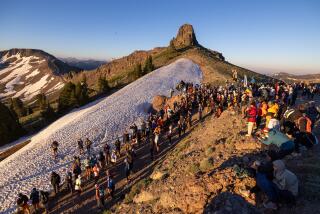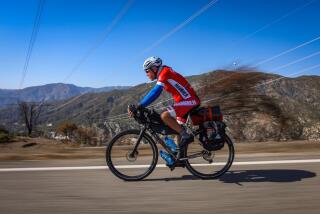RICH DINGES IS ON THE ROAD AGAIN : Runner Comes Back--One Step at a Time : Freak Bicycling Injury Left HimTemporarily Paralyzed, Determined
- Share via
Rich Dinges made an instinctive decision to steer his bicycle into a curb rather than risk being run over by an inattentive driver. That choice on March 27, 1983, quite possibly saved his life. It certainly altered it irrevocably.
“You know I was going very slowly, less than 10 m.p.h., and when I hit the curb, I thought ‘Well, this is going to be one of those things where I skin a knee or an elbow and that will be it,’ ” said Dinges, a section head in the engineering division at Hughes Aircraft Co.
“I wasn’t knocked out, but I hit the curb with my head--luckily I had a helmet, cause if it wasn’t for that I wouldn’t be here, today--and then landed head first on the grass.
“You know my lab manager is a bicycle racer, and in the past, we had talked about getting in accidents. And he said the worst thing that could happen was a separated shoulder.
“So the first sensation I remember was looking at my arm and it was just dangling there. I thought, ‘Geez, I dislocated my shoulder.’ Then I tried to get up and there was nothing. Nothing at all. No feeling.
“Before that, I was more worried about how bad my bike was broken up. And you know it didn’t have a scratch.”
Dinges, 45, wasn’t nearly as lucky. X-rays revealed a compression fracture. Two vertebrae had jammed together against a disc, putting pressure on the nerves and causing temporary paralysis from the neck down.
Attempting to alleviate the stress, Dr. Asher Taban, a neurosurgeon from Northridge Hospital, placed Dinges in a vise-like clamp for 72 hours.
“For most of the first day I was scared because I had no feeling,” Dinges said. “You try not to focus on the negative, but I was scared. Then I started to get a tingling feeling in my whole body because the nerves were coming back. It was quite uplifting because you know that you have done something very bad to yourself and you realize that it could have been so much worse.
“That’s when I decided I had to come back, not just to re-teach myself to do normal, every-day things, but to run again.”
Dinges admits he was never fast, but he loved to run. His passion for distance began harmlessly enough in 1977, the mileage merely a way to get in shape for a winter of skiing.
“You know, you run three miles and wonder what it’s like to go 5, then 10, and finally I wanted to try marathons. I just became wrapped up in it,” said the bachelor from Reseda.
“It was quite enjoyable. There were the personal rewards in the challenge of what an individual can try to achieve.
“There is also the group aspect. A large number of people from all walks of life run and they come from such diverse backgrounds. I made many friends and I truly cherished that aspect of it.”
Somewhere along the road to more than 30 marathons, Dinges opted for a larger challenge, the ultra-marathon, courses covering 50 miles or more. His favorite is the Western States 100 endurance run, 100 miles of pain starting at Squaw Valley and ending in Auburn, Calif.
The 12th edition of the race will be held this weekend, with more than 325 participants expected to take on the mountainous terrain.
“The ultras become almost an obsession,” Dinges said. “You have to have a lot of patience and endurance to compete because you get to a point where you hurt and you’ve got to force yourself to go on. After all the work, it’s not easy to quit. When I finished my first Western in 1979, I cried because I was so elated. You have to keep pushing.”
Perseverance characterizes Dinges’ voice, determination his physique, still hampered by a pronounced limp.
“After the clamp, they put you in a halo brace for three months,” Dinges said. “It’s a stainless steel ring they screw into your skull and then there are four rods which connect to a large fiberglass vest which immobilizes your neck. That was on for three months. They have a good rehab program at Northridge and they’d work you for about six hours a day.
“After the initial tingling, you get a little movement in the toes and fingertips. The left side came first, the right side is still lagging. After two months, I got out of the hospital, and I could feed and wash myself, do enough to take care of myself. But it takes time.
“If you saw me a year ago or even three months ago, the change has been dramatic. But the day-to-day recovery is so slow. I wasn’t content, though. All my friends were rooting for me and I guess I refused to believe this was going to stop me. So even when I had the halo, I tried to walk a quarter mile a day. Then I tried more and more, walking and walking. And gradually I started running.”
While he was in the hospital, Charlie and Ava Hoover, two of his closest friends, brought him breakfast every day. The menu also included a big helping of good cheer and a message: Don’t give up.
He took the message to heart. In March 1984, Dinges was on Catalina Island for a marathon. He made a mental commitment to himself--that he would finish whether he ran, walked or crawled. He ran the first few miles, but his stamina soon deserted him. So he started to walk. Seven hours later he reached the finish line.
“I thought I had it figured that no one would see me,” Dinges said. “You know sometimes the nerves don’t connect and I’ll trip or fall. One time I fell and smashed my front teeth. I also broke my hand. So, when I came to the finish I didn’t expect to see anyone.
“But Hans Albrecht, who runs the race, is a good friend of mine and he was very supportive when I was in the hospital. I was so surprised. He had everyone waiting for me when I finished and they all cheered.”
Last summer, Dinges returned to Squaw Valley for the Western States 100. Incredibly, he completed 18 miles on a course whose elevation peaks at over 7,500 feet and drops to 1,000.
This Saturday, he will try to run 60 of the 100 miles, hoping to reach Michigan Bluff. Compared to 1982, when he covered the grueling course in 20 hours 39 minutes, finishing 14th, Dinges hopes to run a 10-minute-per-mile pace, nearly four minutes a mile off his personal best. The program for this year’s Western includes a picture of Dinges. Underneath the photo is a quotation from Dag Hammerskjold, the late Secretary General of the United Nations, extoling the indomitable human spirit:
” . . . to keep alive the incentive to push on further, that pain in the soul that drives us on further.”
Dinges still goes back to Northridge for an occasional checkup, but mostly he goes back to visit with friends who may never leave the hospital, to offer living proof that it is possible to strive to overcome an injury, to lead a normal life.
“I force myself to write with my right hand,” he says. “If you don’t use it, you’ll lose it. I still don’t have balance and quickness on my right side. But you cannot waste energy dwelling on the negative, on the pain. This isn’t like cutting yourself with a knife or breaking a bone. When that happens, you count the days or weeks and know it will be over. This may never be over. You have to deal with it. You have to have patience.
“I don’t dream about the accident, but I think about it sometimes. Think what might have been different. But I think I’m in good shape, today. And I thank God and go from there.
“You can’t be bothered by remorse. You’ve got to get on with getting better. You’ve got to push through it. I’m going to come back, it may take a while, but I’ll come back.
“Definitely. And next year, I’ll run the whole 100 miles.”
More to Read
Go beyond the scoreboard
Get the latest on L.A.'s teams in the daily Sports Report newsletter.
You may occasionally receive promotional content from the Los Angeles Times.










